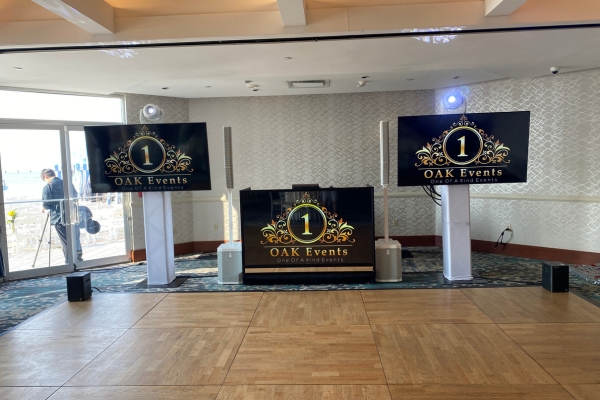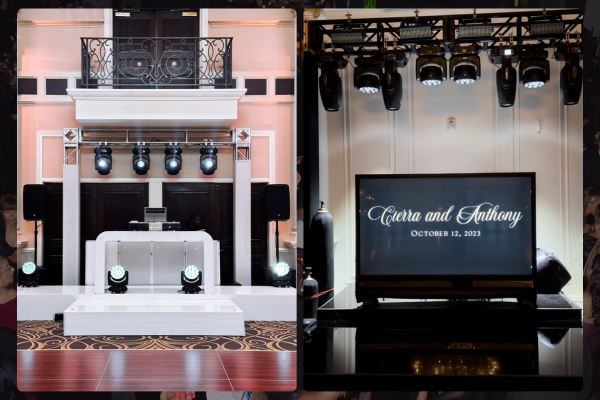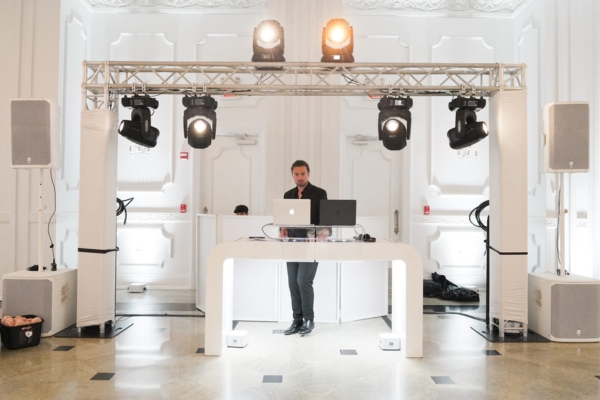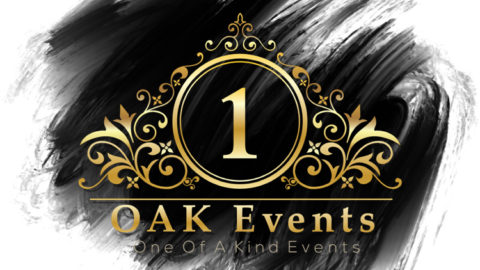When people think about wedding entertainment, the focus often lands on the DJ and the music. But here’s the truth: lighting is just as important. DJ wedding lights aren’t just about making the booth look cool—they set the mood, highlight the venue, and keep the energy flowing all night. From uplighting that transforms the walls to intelligent lights that move with the beat, the right setup can turn a reception into an unforgettable experience.
Lighting is the silent partner to the wedding DJ’s performance. It guides attention, creates ambiance, and makes every key moment—first dances, speeches, and big entrances—feel cinematic. Without it, even the best playlists can fall flat.
Types of DJ Wedding Lighting

Wedding lighting isn’t one-size-fits-all. DJs bring a mix of event lighting styles designed to fit the space, theme, and energy of the celebration. Here are the most common types couples should know:
Uplighting / Accent Wash
Uplighting is a favorite at weddings because it instantly elevates the room. By placing lights along walls, columns, or architectural features, DJs create soft washes of color that transform plain spaces into glowing, romantic backdrops. Want elegance? Go with amber or warm white. Want energy? Deep purples and blues do the trick.
Moving Head & Intelligent Lighting
These are the lights that spin, tilt, and follow the music. Intelligent lights create dynamic effects like sweeping beams, shifting colors, and even spotlighting the couple during special moments. They’re the go-to for energizing the dance floor and keeping the vibe fresh.
Pin Spotting & Spotlights
Subtle but powerful, pin spots highlight details like the wedding cake, floral arrangements, or even the couple during their first dance. Spotlights draw attention where it matters most, ensuring nothing beautiful goes unnoticed.
LED Video Walls & Screen Displays
Screens and video walls bring a modern, immersive edge to weddings. DJs can display the couple’s names, show live dance floor footage, or even sync visuals to the music. They’re also perfect for branding at corporate events, making them versatile beyond weddings.
Dance Floor Wash & Strobe Effects
Dance floor washes flood the main party space with vibrant color, while strobes add bursts of high-energy flashes. Used carefully, strobes ramp up excitement but need to be managed for photography and guest comfort.
Special Effects Lighting (Gobos, Lasers, CO₂, Cold Sparks)
For couples looking to go all out, special effects bring the “wow” factor. Gobos project custom patterns or monograms, lasers cut through the air with dramatic flair, CO₂ jets create a club-like vibe, and cold spark fountains add safe, indoor fireworks. Each effect requires coordination with the venue for safety and power needs, but they leave lasting impressions.
Benefits of Professional Wedding Lighting

Lighting does more than look pretty—it shapes the entire guest experience. Here’s why professional DJ wedding lights are worth the investment:
Elevated Venue Aesthetic & Mood Setting
Lighting can completely transform a space. By adjusting brightness and color temperature, DJs create a warm, romantic glow for dinner and then switch to bold, vibrant tones when it’s time to dance.
DJ Visibility & Booth Presence
The DJ booth isn’t just a work station—it’s part of the show. When lit properly, it enhances the performer’s energy and makes them a visual centerpiece that draws guests onto the dance floor.
Photo & Video Optimization
Photographers love well-planned lighting. It eliminates harsh shadows, balances skin tones, and makes every shot Instagram-worthy. Guests and couples alike benefit when the setup is designed with cameras in mind.
Seamless Timeline & Moment Highlighting
Lighting can act as a subtle signal. A spotlight cues the couple’s entrance, a color shift sets the tone for the first dance, and a wash over the crowd can build anticipation for the bouquet toss. It helps keep the reception flowing naturally.
Branding & Personalization
From projecting names on the dance floor with gobos to syncing the color scheme with the couple’s theme, lighting allows for endless customization. It’s more than décor—it’s a personal stamp on the night.
Setting Up the DJ Booth & Lighting Structure

The DJ booth isn’t just a table with gear—it’s the centerpiece of the entertainment. How you stage and light it can set the tone for the entire reception.
Booth Shapes & Materials (Sleek, LED-Integrated, Custom)
Booths come in all shapes and finishes, from minimal white facades to LED-integrated panels that display visuals. White booths look modern and clean, while LED cabinets allow for branding, logos, or themed graphics. Custom built DJ booths let couples showcase personality, creating a booth that blends seamlessly with the décor.
Truss vs. Totem vs. T-Bar Mounting Options
Lighting fixtures need stable structures. Trusses form a full frame around the DJ booth, giving symmetry and plenty of room for lights. Totems are vertical columns that create a sleek look while saving space. T-bars are the simplest option—affordable and practical for smaller venues, though less dramatic in appearance.
Cable Management & Power Planning
Nothing kills the vibe like a messy setup. Clean cable runs not only look professional but also keep guests safe. DJs often use floor covers or tape-down systems. Power should be distributed across circuits to prevent overload, and backup circuits or surge protection ensure the lights don’t cut out mid-reception. DMX cabling allows for full control and synchronization across fixtures.
Control Systems—DMX, Sound-Active, Wireless/Uplights
There are several ways to run a light show. DMX control offers precision and programmable sequences, perfect for syncing with music. Sound-active lighting reacts to beats automatically—great for high-energy dance floors but less reliable for polished transitions. Wireless uplights give flexibility in placement but need regular charging. Each system has pros and cons, and the best setups often mix multiple approaches.
Venue Coordination & Safety Considerations
Every venue has its quirks. DJs and lighting techs must account for ceiling height, fire alarms, sprinkler systems, and ADA pathways. Special effects like CO₂ or cold sparks usually require permits or at least venue approval. The safest setups look intentional, clean, and unobtrusive to guests.
Lighting Planning for Your Wedding Venue
Every venue has different needs, so planning the right lighting layout is key to success.
Venue Type Adjustments (Indoor vs. Outdoor)
Indoor spaces provide consistent power and controlled environments, while outdoor venues add challenges like weatherproofing and portable power. For a tented wedding, uplights and wireless fixtures shine, while outdoor lawns may require generators and weather-rated gear.
Ceiling Height & Lighting Impact Zones
Tall ballrooms allow dramatic overhead lighting, moving beams, and truss rigs. Narrow or low-ceiling spaces benefit from wall washes, subtle uplighting, and totem-mounted fixtures that don’t overwhelm the room. The key is matching the scale of the lighting to the room size.
Budget-Friendly vs. Premium Packages
Couples don’t need to break the bank for lighting. Budget-friendly setups might include uplights and a simple booth wash, while premium packages offer video walls, intelligent lighting rigs, and special effects. Add-ons like haze machines or custom monograms fall in between, offering high impact at a modest cost.
Backup Plans & Redundancy
Things don’t always go as planned, so professional DJs bring backup. Spare fixtures, wireless battery-powered lights, and extra cabling ensure the show goes on. Having redundancy built in separates seasoned pros from amateurs.
Technical & Creative Tips for Superior Lighting
Lighting isn’t just technical—it’s creative. A thoughtful approach makes the event feel polished, immersive, and unforgettable.
Color Psychology & Palette Coordination with Decor
Colors influence mood. Warm tones like amber create romance, while bold colors like blue and purple bring energy. Matching the lighting palette to florals, linens, or wedding colors creates a cohesive design that feels intentional.
Photography-Friendly Lighting Techniques
Harsh beams or rapid strobes can ruin photos. Softening lights, balancing brightness, and avoiding extreme contrast ensures every shot looks natural. Professionals also coordinate with photographers to avoid issues with flicker or overexposure.
Synchronized Lighting with Music & Effects
When lights move with the music, the energy is magnetic. Using BPM-synced programming or pre-designed sequences, DJs can time lighting to bass drops or chorus peaks. Manual adjustments add flexibility for speeches and first dances.
Testing & Load-In Checklist
Before guests arrive, pros run a full test: checking circuits, syncing DMX channels, and rehearsing lighting cues. Proper load-in includes aligning fixtures, setting brightness levels, and confirming timing for key moments.
Frequently Asked Questions
Are strobes and lasers safe to use at weddings?
Yes, when handled by professionals. DJs limit strobe frequency and laser angles to ensure guest comfort and safety.
How many fixtures do I need per square footage?
A standard rule is one uplight every 6–12 feet of wall space. Dance floor coverage depends on the size, but at least two moving heads keep the floor lively.
How do DJs coordinate with photographers?
Lighting techs and DJs usually check in with photographers before the reception starts. This avoids issues with overexposure and ensures important shots look natural.
What’s the backup plan if lights fail?
Pros bring extra fixtures, battery-powered uplights, and backup controllers. If something goes out, the show continues without interruption.
Can lighting affect guests with sensitivities?
Yes, strobes or intense flashes may bother guests with epilepsy or migraines. Good DJs adjust settings and can skip certain effects if requested.
Glossary & Lighting Lingo
Here’s a quick rundown of common lighting terminology you’ll hear:
-
Uplights: Fixtures that project color washes upward along walls or columns.
-
Moving Heads: Intelligent lights that pan, tilt, and change colors or patterns.
-
DMX: A control system that lets DJs program lighting sequences.
-
Strobe: A rapid-flashing light used for high-energy dance effects.
-
Wash Light: A fixture that covers large areas in soft, even color.
-
Gobo: A template that projects shapes, patterns, or monograms.
-
Video Wall: A large LED display for visuals, branding, or live feeds.
-
Monogram Projection: A light design displaying names, initials, or logos.
-
Pin Spot: A small beam that highlights details like cakes or centerpieces.
-
Haze Machine: Creates a light mist that enhances beams and patterns.
Conclusion
Lighting is more than an add-on—it’s what takes a wedding from “nice” to “unforgettable.” With the right mix of uplighting, moving heads, booth effects, and personalized touches, DJ wedding lights set the mood, spotlight the memories, and keep the dance floor packed.
When planning your wedding, think about lighting as part of the design, not just the entertainment. Small decisions—like choosing the right colors or booth setup—can make a big impact on your photos, your vibe, and your guests’ experience.
Ready to see how lighting can transform your wedding? Contact us today to explore customizable packages, our expert wedding DJ team, schedule a consultation, and start building the perfect atmosphere for your celebration.
